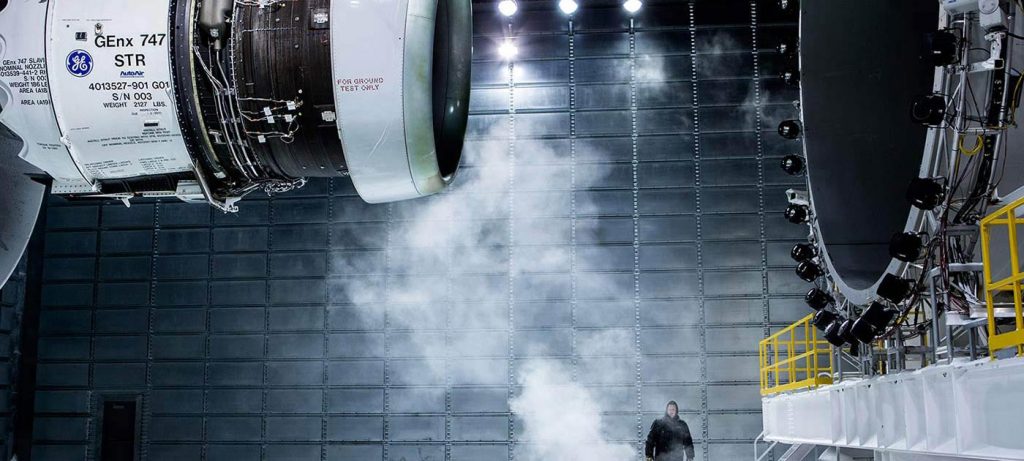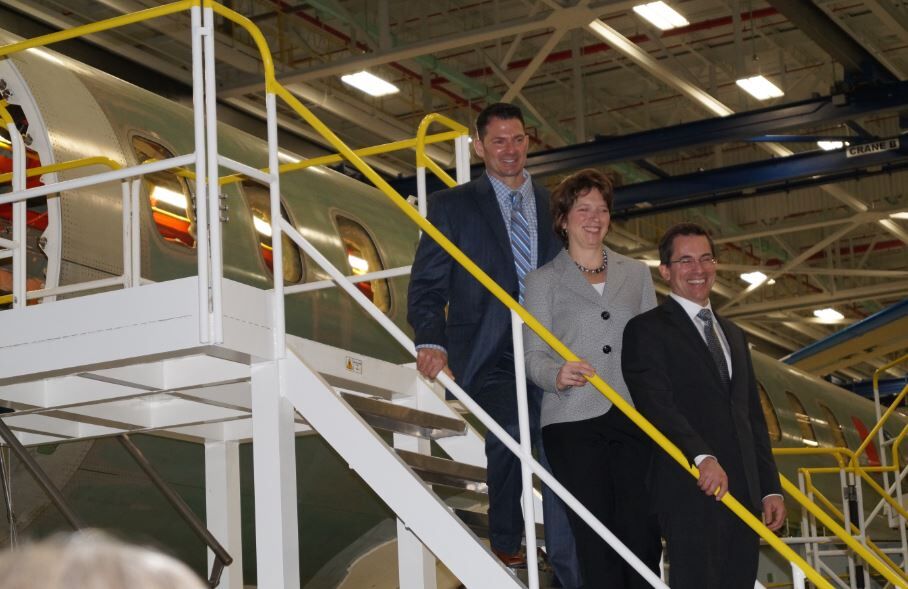
Kathy MacKenzie
General Manager GEnx product line
GE Aviation
It is an interesting twist on the theory of six degrees of separation that every time you get on a Qantas or Jetstar 787 (and a majority of 787s with airlines worldwide for that matter) you have, in part, to thank Kathy MacKenzie and her team for getting you to your destination safely and efficiently.
Assuming the airlines do their bit, that is.
MacKenzie is the General Manager of the GEnx program for GE Aviation and, put simply, that means she is in charge of the team behind the power attached to the airframe: those two huge engines many take for granted but which help, for example, deliver Qantas 787-9 passengers between Perth and London – the third longest flight on the planet.
Put in GE technical-speak the GEnx’s innovative features are a twin-annular pre-swirl (TAPS) combustor that dramatically reduce NOx gases while larger, more efficient fan blades help make the GEnx the quietest commercial aircraft engine GE has ever produced.
“The GEnx engine is also the world’s first commercial jet engine with both a front fan case and fan blades made of carbon-fiber composites.”
Or, as the marketing people tell it: The GEnx is the fastest-selling, high-thrust jet engine in GE Aviation history with more than 1,600 engines on order.
In addition to being the best-selling engine for the Dreamliner (about 65 per cent of the 787 market) GEnx also powers the four-engine Boeing 747-8.
No matter what the spin, it does add up to an impressive success story and one of which MacKenzie is justifiably proud – not for herself particularly but for the GEnx team and what she describes as GE’s strong customer support.
That includes the embedding of customer support teams within airlines. “They are just part of the team.” she said.
A field support team of GE Aviation engineers is stationed in Melbourne, Sydney, Brisbane and London, backed by fleet support specialists who analyse real-time flight data. The team also has 24/7 operations centres in Shanghai, Dubai and Cincinnati.
MacKenzie’s oversight runs the gamut of the GEnx program, from design to manufacturing, to sales, costs and customer liaison. And it is the latter which brought her to Australia in April for discussions with GEnx customers Qantas and Jetstar.
She is one of several general managers, each in charge of a different engine program such as the GE90 and GP7000 and the CFM-LEAP joint venture.
The GP7000 is a joint-venture between GE Aviation and Pratt & Whitney (called the Engine Alliance) and used on the Airbus A380.

Meanwhile the CFM-LEAP joint venture is between GE Aviation and Safran Aircraft Engines and is used on the Boeing 737 MAX and Airbus A320neo family of aircraft.
It was a whirlwind visit for MacKenzie – in early on a Monday morning via the Qantas direct A380 service from Dallas, and out again within 36 hours – but with enough time to speak with Australian Aviation about her job, her career with GE and some reflections on how opportunities for women in non-traditional roles such as engineering have progressed in the US.
And GE has been at the very heart of MacKenzie’s own career progression, straight from college where she graduated with a degree in mechanical engineering in 1990. Her interest in engineering evolved slowly from a base of a keen interest at school in science and maths.
“I was just a normal kid. I liked math and science. I did well at school, but I didn’t really have a particular passion for aviation or the automobile industry. I just really, I would say, followed my interests – more on a kind of a step by step basis versus a life-long passion.
That step-by-step saw her walk out of college armed with her bachelor’s degree and into the engineering development program at GE. “At the time, I didn’t even know GE made jet engines. Is that hard to believe?”
She found out about them soon enough on the two-year rotational program which involved not only classes in jet engines but plenty of hands-on work on first military and, subsequently, commercial types. The end result was a master’s degree in mechanical engineering and a pathway to her current senior position in the organisation.
She said GE is very proactive in the development of a greater focus on STEM in schools, “in terms of getting kids interested”, through its company outreach program and that there has been a noticeable shift in reaching out to younger cohorts than previously. “It is very active and GE is active with it. Really, in Cincinnati (where MacKenzie lives and GE Aviation headquarters is based), we have STEM outreach into junior high.
“We (then) reach out further in high school to ensure that the girls stay interested in maths and science as they come through and into college.
“We’re really looking for the best and the brightest.”
MacKenzie said she believes pathways for women entering the engineering profession in the US are as defined as they are for men: “I don’t think there’s anything particular that’s a pathway for women that’s different from men.”

There are, however, some stark contrasts compared with some of the gender-orientated employment statistics emerging from the aviation sector in Australia.
MacKenzie said between 40 and 50 per cent (and closer to 50) of new employees hired by GE are women.
So what’s next for MacKenzie?
Right now she is not seeing an end in sight to the GEnx program. Sales are strong. “We’re very pleased with the sales so far. It’s actually the fastest selling widebody engine program in history. We’ve won about 65 per cent of widebody orders and also had about 65 per cent of the 787s.”
“There’s really no other widebody under development right now (suited to GEnx), except in China (where China’s Comac and Russia’s United Aircraft Corporation) developing the CR929, a 250-320 seat twin jet
MacKenzie’s team is already in discussions with Comac, just as it has ongoing discussions with Boeing and Airbus. “It’s all part of the business model,” MacKenzie said.
“We’re targeting about 250 seats over, like, 5,500nm, so watch the later part of the next decade, round 2027. We are in the process of bidding to be the propulsion system provider for that application.
She said statistics show proven fuel efficiency is one of the core advantages of GEnx compared with competitors such as the Trent 1000.
According to GE, the GEnx-1B, designed specifically for the 787 Dreamliner delivers a two per cent fuel burn advantage over its competition and a one per cent advantage with respect to fuel burn retention.
GEnx-2B, optimised for the Boeing 747-8 features a smaller fan, de-staged booster and de-staged low-pressure turbine. “The GEnx-2B contains an identical core and similar materials as the GEnx-1B to provide synergies for mixed GEnx fleets.”

In an article published in AIN Online last year she said she anticipated a market for another 1,800 GEnx suited aircraft over the 20 years. “We will get 1,200 of those,” she was quoted as saying.
In the meantime, the GEnx team is undertaking a process of engineering analysis to maintain the best possible ongoing effectiveness of the engines.
“We are in what I call study mode,” she said.
Career snapshot:
– BS in Mechanical Engineering, Northeastern University
– MS in Mechanical Engineering from MIT
– Design engineer
– Account manager Bombardier CF34-8C program, then Southwest Airlines account manager on the CFM56-3 and 7 programs.
– Regional GM Commercial Operations for Asia, China and North America
– CF6 program director customer and commercial in 2009, director Embraer programs CF-34, general manager mature fleet programs, general manager regional engines and services.
– General Manager GEnx product line.













